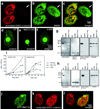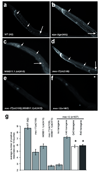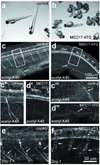MEC-17 is an alpha-tubulin acetyltransferase
- PMID: 20829795
- PMCID: PMC2938957
- DOI: 10.1038/nature09324
MEC-17 is an alpha-tubulin acetyltransferase
Abstract
In most eukaryotic cells, subsets of microtubules are adapted for specific functions by post-translational modifications (PTMs) of tubulin subunits. Acetylation of the epsilon-amino group of K40 on alpha-tubulin is a conserved PTM on the luminal side of microtubules that was discovered in the flagella of Chlamydomonas reinhardtii. Studies on the significance of microtubule acetylation have been limited by the undefined status of the alpha-tubulin acetyltransferase. Here we show that MEC-17, a protein related to the Gcn5 histone acetyltransferases and required for the function of touch receptor neurons in Caenorhabditis elegans, acts as a K40-specific acetyltransferase for alpha-tubulin. In vitro, MEC-17 exclusively acetylates K40 of alpha-tubulin. Disruption of the Tetrahymena MEC-17 gene phenocopies the K40R alpha-tubulin mutation and makes microtubules more labile. Depletion of MEC-17 in zebrafish produces phenotypes consistent with neuromuscular defects. In C. elegans, MEC-17 and its paralogue W06B11.1 are redundantly required for acetylation of MEC-12 alpha-tubulin, and contribute to the function of touch receptor neurons partly via MEC-12 acetylation and partly via another function, possibly by acetylating another protein. In summary, we identify MEC-17 as an enzyme that acetylates the K40 residue of alpha-tubulin, the only PTM known to occur on the luminal surface of microtubules.
Figures





Similar articles
-
The major alpha-tubulin K40 acetyltransferase alphaTAT1 promotes rapid ciliogenesis and efficient mechanosensation.Proc Natl Acad Sci U S A. 2010 Dec 14;107(50):21517-22. doi: 10.1073/pnas.1013728107. Epub 2010 Nov 10. Proc Natl Acad Sci U S A. 2010. PMID: 21068373 Free PMC article.
-
MEC-12, an alpha-tubulin required for touch sensitivity in C. elegans.J Cell Sci. 1999 Feb;112 ( Pt 3):395-403. doi: 10.1242/jcs.112.3.395. J Cell Sci. 1999. PMID: 9885292
-
Synaptic branch stability is mediated by non-enzymatic functions of MEC-17/αTAT1 and ATAT-2.Sci Rep. 2022 Aug 17;12(1):14003. doi: 10.1038/s41598-022-18333-2. Sci Rep. 2022. PMID: 35977998 Free PMC article.
-
Tubulin acetylation: responsible enzymes, biological functions and human diseases.Cell Mol Life Sci. 2015 Nov;72(22):4237-55. doi: 10.1007/s00018-015-2000-5. Epub 2015 Jul 31. Cell Mol Life Sci. 2015. PMID: 26227334 Free PMC article. Review.
-
The growing landscape of tubulin acetylation: lysine 40 and many more.Biochem J. 2016 Jul 1;473(13):1859-68. doi: 10.1042/BCJ20160172. Biochem J. 2016. PMID: 27354562 Review.
Cited by
-
Microtubule-driven spatial arrangement of mitochondria promotes activation of the NLRP3 inflammasome.Nat Immunol. 2013 May;14(5):454-60. doi: 10.1038/ni.2550. Epub 2013 Mar 17. Nat Immunol. 2013. PMID: 23502856
-
Lysine post-translational modifications and the cytoskeleton.Essays Biochem. 2012;52:135-45. doi: 10.1042/bse0520135. Essays Biochem. 2012. PMID: 22708568 Free PMC article. Review.
-
Pathologically relevant aldoses and environmental aldehydes cause cilium disassembly via formyl group-mediated mechanisms.J Mol Cell Biol. 2024 Jul 1;16(1):mjad079. doi: 10.1093/jmcb/mjad079. J Mol Cell Biol. 2024. PMID: 38059869 Free PMC article.
-
Impaired Coenzyme A metabolism affects histone and tubulin acetylation in Drosophila and human cell models of pantothenate kinase associated neurodegeneration.EMBO Mol Med. 2011 Dec;3(12):755-66. doi: 10.1002/emmm.201100180. Epub 2011 Oct 14. EMBO Mol Med. 2011. PMID: 21998097 Free PMC article.
-
Microtubules in Influenza Virus Entry and Egress.Viruses. 2020 Jan 17;12(1):117. doi: 10.3390/v12010117. Viruses. 2020. PMID: 31963544 Free PMC article. Review.
References
-
- Nogales E, Whittaker M, Milligan RA, Downing KH. High-resolution model of the microtubule. Cell. 1999;96:79–88. - PubMed
-
- Steczkiewicz K, Kinch L, Grishin NV, Rychlewski L, Ginalski K. Eukaryotic domain of unknown function DUF738 belongs to Gcn5-related N-acetyltransferase superfamily. Cell Cycle. 2006;5:2927–2930. - PubMed
-
- Chalfie M, Au M. Genetic control of differentiation of the Caenorhabditis elegans touch receptor neurons. Science. 1989;243:1027–1033. - PubMed
Publication types
MeSH terms
Substances
Grants and funding
LinkOut - more resources
Full Text Sources
Other Literature Sources
Molecular Biology Databases
Miscellaneous

